FIAT DOBLO COMBI 2016 2.G Owners Manual
Manufacturer: FIAT, Model Year: 2016, Model line: DOBLO COMBI, Model: FIAT DOBLO COMBI 2016 2.GPages: 298, PDF Size: 25.92 MB
Page 201 of 298
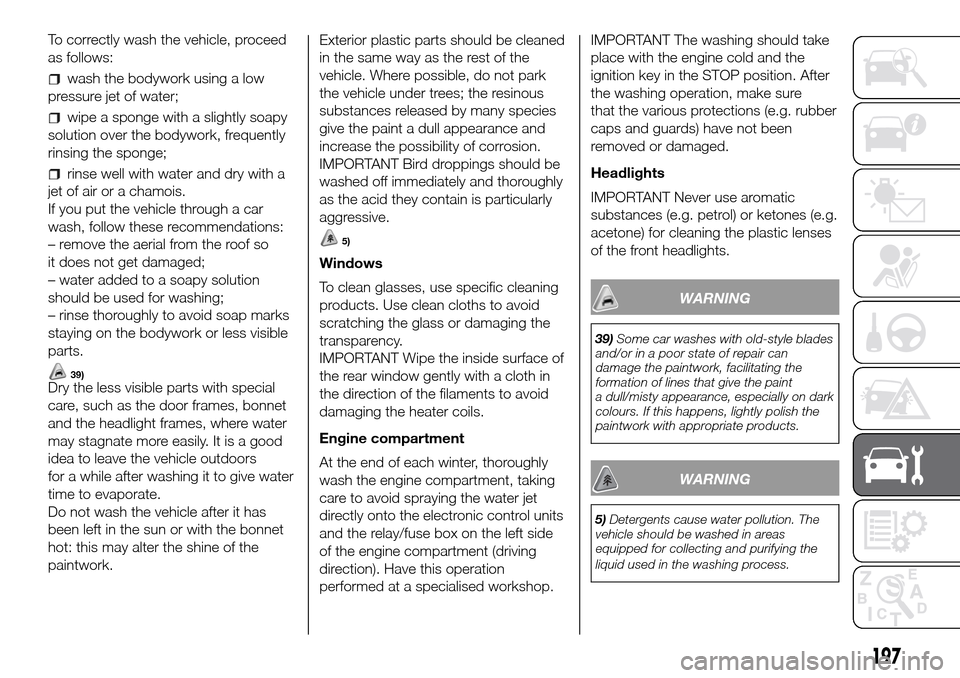
To correctly wash the vehicle, proceed
as follows:
wash the bodywork using a low
pressure jet of water;
wipe a sponge with a slightly soapy
solution over the bodywork, frequently
rinsing the sponge;
rinse well with water and dry with a
jet of air or a chamois.
If you put the vehicle through a car
wash, follow these recommendations:
– remove the aerial from the roof so
it does not get damaged;
– water added to a soapy solution
should be used for washing;
– rinse thoroughly to avoid soap marks
staying on the bodywork or less visible
parts.
39)Dry the less visible parts with special
care, such as the door frames, bonnet
and the headlight frames, where water
may stagnate more easily. It is a good
idea to leave the vehicle outdoors
for a while after washing it to give water
time to evaporate.
Do not wash the vehicle after it has
been left in the sun or with the bonnet
hot: this may alter the shine of the
paintwork.Exterior plastic parts should be cleaned
in the same way as the rest of the
vehicle. Where possible, do not park
the vehicle under trees; the resinous
substances released by many species
give the paint a dull appearance and
increase the possibility of corrosion.
IMPORTANT Bird droppings should be
washed off immediately and thoroughly
as the acid they contain is particularly
aggressive.
5)
Windows
To clean glasses, use specific cleaning
products. Use clean cloths to avoid
scratching the glass or damaging the
transparency.
IMPORTANT Wipe the inside surface of
the rear window gently with a cloth in
the direction of the filaments to avoid
damaging the heater coils.
Engine compartment
At the end of each winter, thoroughly
wash the engine compartment, taking
care to avoid spraying the water jet
directly onto the electronic control units
and the relay/fuse box on the left side
of the engine compartment (driving
direction). Have this operation
performed at a specialised workshop.IMPORTANT The washing should take
place with the engine cold and the
ignition key in the STOP position. After
the washing operation, make sure
that the various protections (e.g. rubber
caps and guards) have not been
removed or damaged.
Headlights
IMPORTANT Never use aromatic
substances (e.g. petrol) or ketones (e.g.
acetone) for cleaning the plastic lenses
of the front headlights.
WARNING
39)Some car washes with old-style blades
and/or in a poor state of repair can
damage the paintwork, facilitating the
formation of lines that give the paint
a dull/misty appearance, especially on dark
colours. If this happens, lightly polish the
paintwork with appropriate products.
WARNING
5)Detergents cause water pollution. The
vehicle should be washed in areas
equipped for collecting and purifying the
liquid used in the washing process.
197
Page 202 of 298
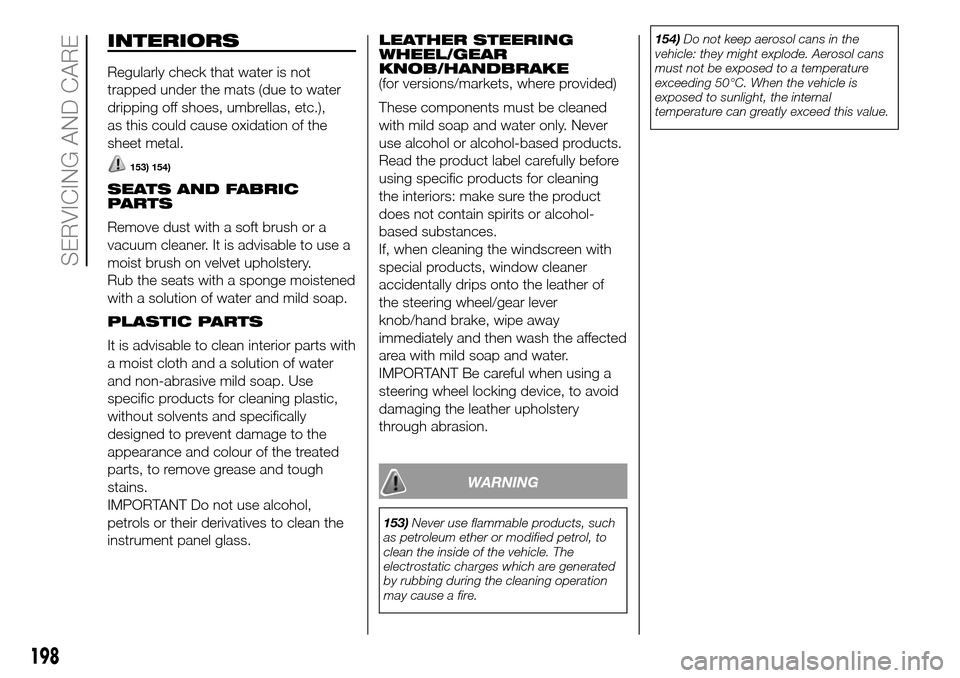
INTERIORS
Regularly check that water is not
trapped under the mats (due to water
dripping off shoes, umbrellas, etc.),
as this could cause oxidation of the
sheet metal.
153) 154)
SEATS AND FABRIC
PARTS
Remove dust with a soft brush or a
vacuum cleaner. It is advisable to use a
moist brush on velvet upholstery.
Rub the seats with a sponge moistened
with a solution of water and mild soap.
PLASTIC PARTS
It is advisable to clean interior parts with
a moist cloth and a solution of water
and non-abrasive mild soap. Use
specific products for cleaning plastic,
without solvents and specifically
designed to prevent damage to the
appearance and colour of the treated
parts, to remove grease and tough
stains.
IMPORTANT Do not use alcohol,
petrols or their derivatives to clean the
instrument panel glass.LEATHER STEERING
WHEEL/GEAR
KNOB/HANDBRAKE
(for versions/markets, where provided)
These components must be cleaned
with mild soap and water only. Never
use alcohol or alcohol-based products.
Read the product label carefully before
using specific products for cleaning
the interiors: make sure the product
does not contain spirits or alcohol-
based substances.
If, when cleaning the windscreen with
special products, window cleaner
accidentally drips onto the leather of
the steering wheel/gear lever
knob/hand brake, wipe away
immediately and then wash the affected
area with mild soap and water.
IMPORTANT Be careful when using a
steering wheel locking device, to avoid
damaging the leather upholstery
through abrasion.
WARNING
153)Never use flammable products, such
as petroleum ether or modified petrol, to
clean the inside of the vehicle. The
electrostatic charges which are generated
by rubbing during the cleaning operation
may cause a fire.154)Do not keep aerosol cans in the
vehicle: they might explode. Aerosol cans
must not be exposed to a temperature
exceeding 50°C. When the vehicle is
exposed to sunlight, the internal
temperature can greatly exceed this value.
198
SERVICING AND CARE
Page 203 of 298
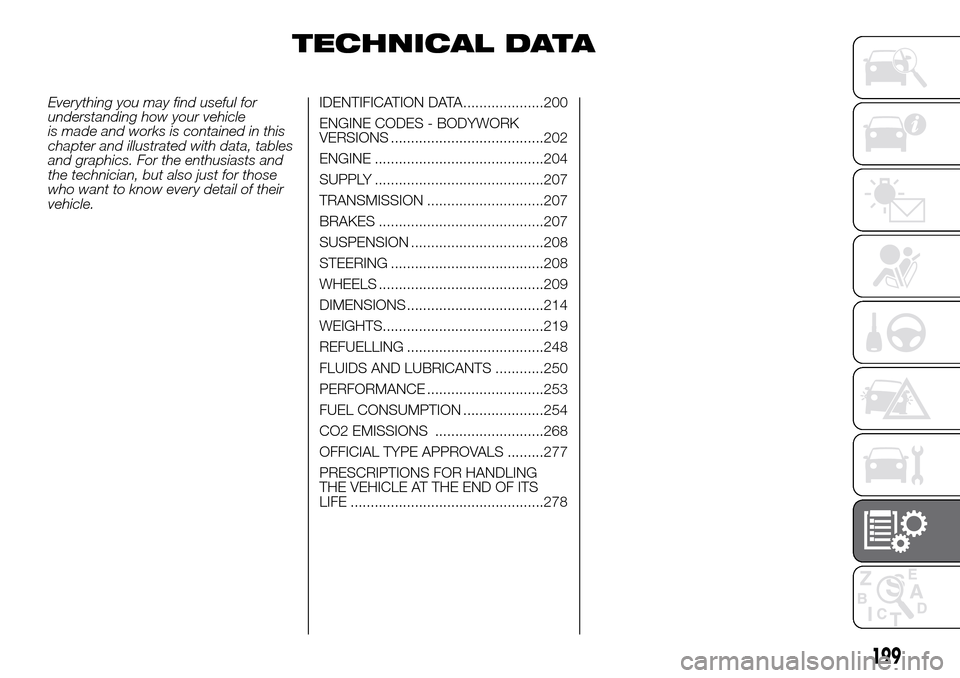
TECHNICAL DATA
Everything you may find useful for
understanding how your vehicle
is made and works is contained in this
chapter and illustrated with data, tables
and graphics. For the enthusiasts and
the technician, but also just for those
who want to know every detail of their
vehicle.IDENTIFICATION DATA....................200
ENGINE CODES - BODYWORK
VERSIONS ......................................202
ENGINE ..........................................204
SUPPLY ..........................................207
TRANSMISSION .............................207
BRAKES .........................................207
SUSPENSION .................................208
STEERING ......................................208
WHEELS .........................................209
DIMENSIONS ..................................214
WEIGHTS........................................219
REFUELLING ..................................248
FLUIDS AND LUBRICANTS ............250
PERFORMANCE .............................253
FUEL CONSUMPTION ....................254
CO2 EMISSIONS ...........................268
OFFICIAL TYPE APPROVALS .........277
PRESCRIPTIONS FOR HANDLING
THE VEHICLE AT THE END OF ITS
LIFE ................................................278
199
Page 204 of 298
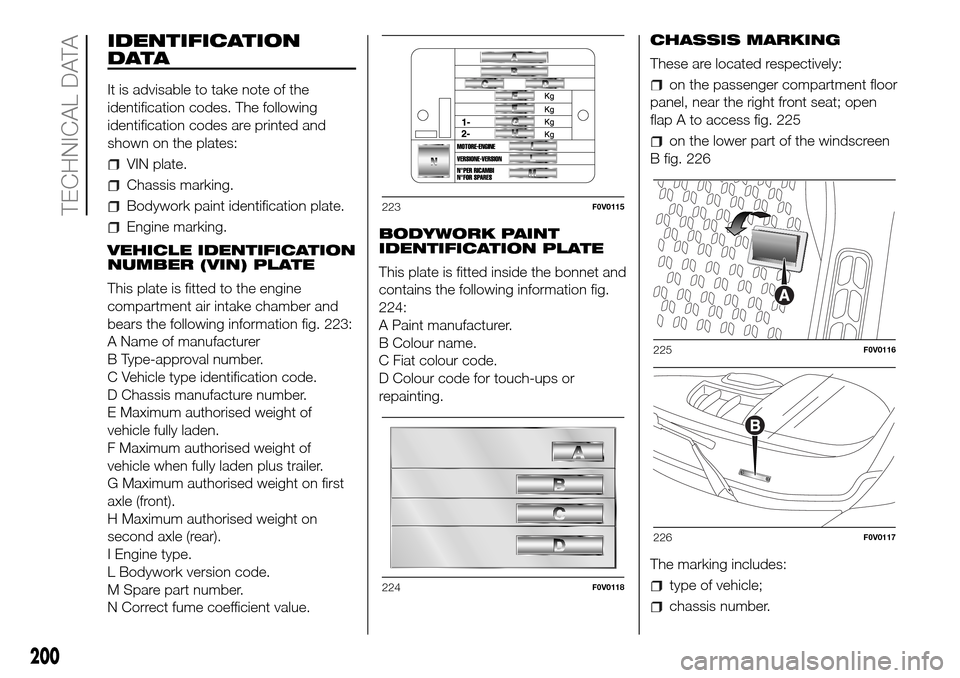
IDENTIFICATION
DATA
It is advisable to take note of the
identification codes. The following
identification codes are printed and
shown on the plates:
VIN plate.
Chassis marking.
Bodywork paint identification plate.
Engine marking.
VEHICLE IDENTIFICATION
NUMBER (VIN) PLATE
This plate is fitted to the engine
compartment air intake chamber and
bears the following information fig. 223:
A Name of manufacturer
B Type-approval number.
C Vehicle type identification code.
D Chassis manufacture number.
E Maximum authorised weight of
vehicle fully laden.
F Maximum authorised weight of
vehicle when fully laden plus trailer.
G Maximum authorised weight on first
axle (front).
H Maximum authorised weight on
second axle (rear).
I Engine type.
L Bodywork version code.
M Spare part number.
N Correct fume coefficient value.BODYWORK PAINT
IDENTIFICATION PLATE
This plate is fitted inside the bonnet and
contains the following information fig.
224:
A Paint manufacturer.
B Colour name.
C Fiat colour code.
D Colour code for touch-ups or
repainting.CHASSIS MARKING
These are located respectively:
on the passenger compartment floor
panel, near the right front seat; open
flap A to access fig. 225
on the lower part of the windscreen
B fig. 226
The marking includes:
type of vehicle;
chassis number.
223F0V0115
224F0V0118
225F0V0116
226F0V0117
200
TECHNICAL DATA
Page 205 of 298
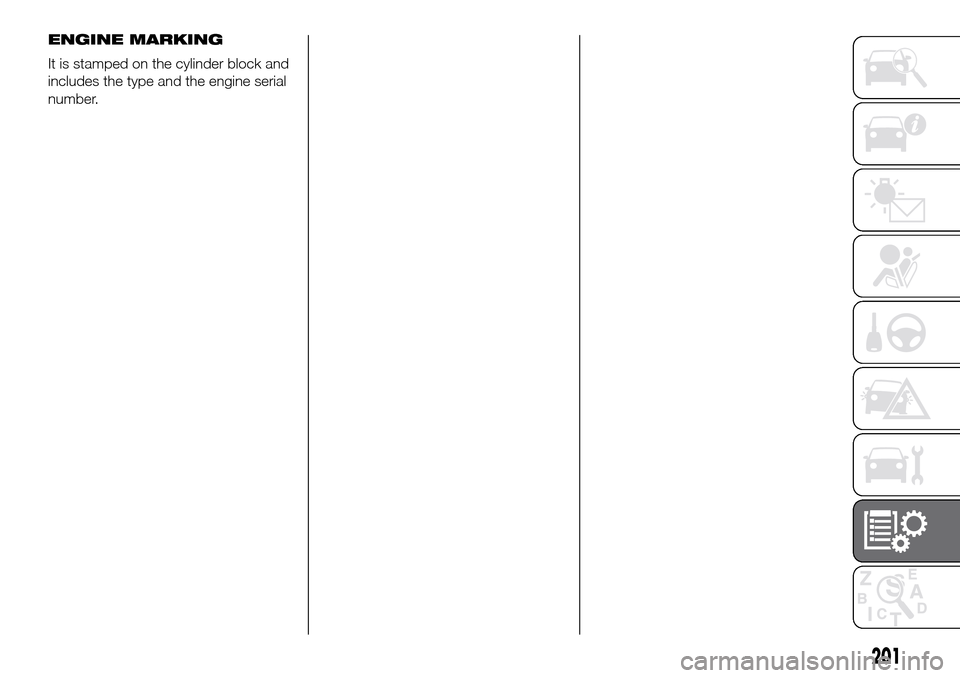
ENGINE MARKING
It is stamped on the cylinder block and
includes the type and the engine serial
number.
201
Page 206 of 298
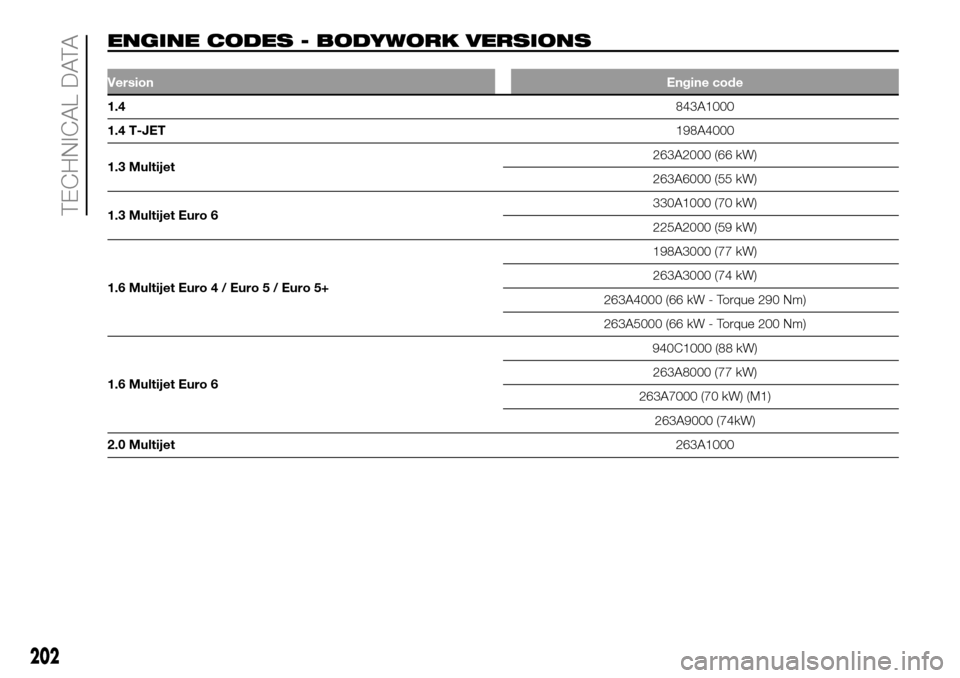
ENGINE CODES - BODYWORK VERSIONS.
VersionEngine code
1.4843A1000
1.4 T-JET198A4000
1.3 Multijet263A2000 (66 kW)
263A6000 (55 kW)
1.3 Multijet Euro 6330A1000 (70 kW)
225A2000 (59 kW)
1.6 Multijet Euro 4 / Euro 5 / Euro 5+198A3000 (77 kW)
263A3000 (74 kW)
263A4000 (66 kW - Torque 290 Nm)
263A5000 (66 kW - Torque 200 Nm)
1.6 Multijet Euro 6940C1000 (88 kW)
263A8000 (77 kW)
263A7000 (70 kW) (M1)
263A9000 (74kW)
2.0 Multijet263A1000
202
TECHNICAL DATA
Page 207 of 298
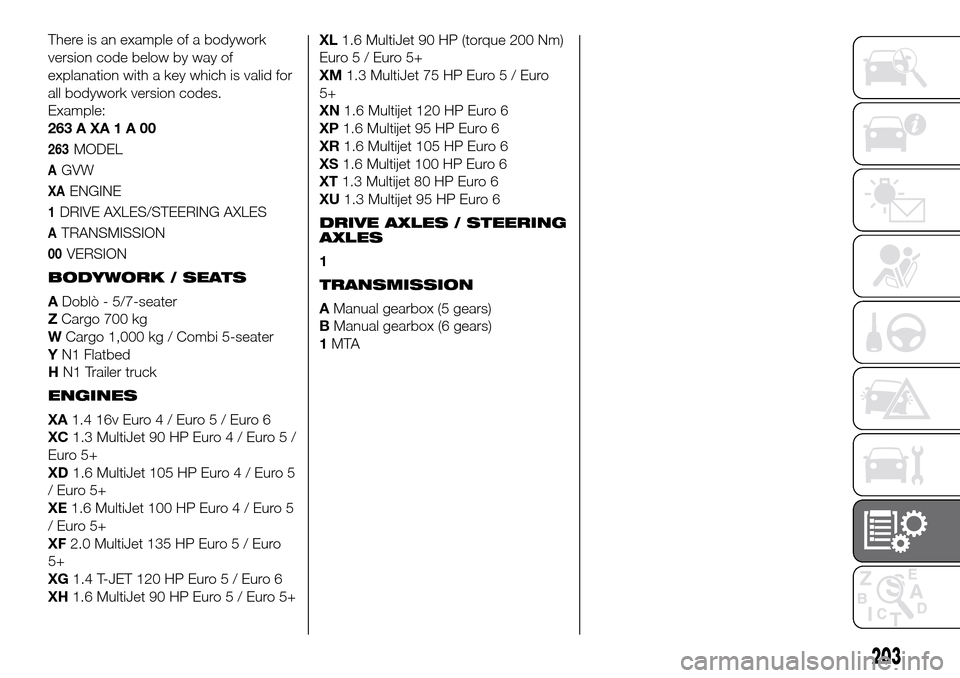
There is an example of a bodywork
version code below by way of
explanation with a key which is valid for
all bodywork version codes.
Example:
263AXA1A00
263MODEL
AGVW
XAENGINE
1DRIVE AXLES/STEERING AXLES
ATRANSMISSION
00VERSION
BODYWORK / SEATS
ADoblò - 5/7-seater
ZCargo 700 kg
WCargo 1,000 kg / Combi 5-seater
YN1 Flatbed
HN1 Trailer truck
ENGINES
XA1.4 16v Euro 4 / Euro 5 / Euro 6
XC1.3 MultiJet 90 HP Euro4/Euro5/
Euro 5+
XD1.6 MultiJet 105 HP Euro4/Euro5
/ Euro 5+
XE1.6 MultiJet 100 HP Euro4/Euro5
/ Euro 5+
XF2.0 MultiJet 135 HP Euro 5 / Euro
5+
XG1.4 T-JET 120 HP Euro5/Euro6
XH1.6 MultiJet 90 HP Euro5/Euro5+XL1.6 MultiJet 90 HP (torque 200 Nm)
Euro 5 / Euro 5+
XM1.3 MultiJet 75 HP Euro 5 / Euro
5+
XN1.6 Multijet 120 HP Euro 6
XP1.6 Multijet 95 HP Euro 6
XR1.6 Multijet 105 HP Euro 6
XS1.6 Multijet 100 HP Euro 6
XT1.3 Multijet 80 HP Euro 6
XU1.3 Multijet 95 HP Euro 6
DRIVE AXLES / STEERING
AXLES
1
TRANSMISSION
AManual gearbox (5 gears)
BManual gearbox (6 gears)
1MTA
203
Page 208 of 298
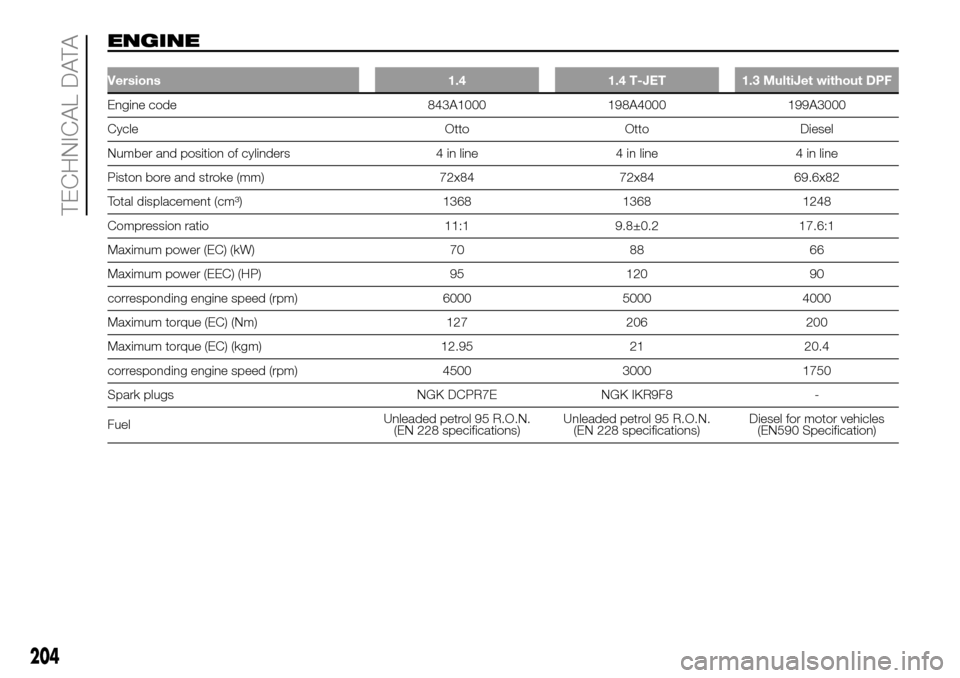
ENGINE
Versions 1.4 1.4 T-JET 1.3 MultiJet without DPF
Engine code 843A1000 198A4000 199A3000
Cycle Otto Otto Diesel
Number and position of cylinders 4 in line 4 in line 4 in line
Piston bore and stroke (mm) 72x84 72x84 69.6x82
Total displacement (cm³) 1368 1368 1248
Compression ratio 11:1 9.8±0.2 17.6:1
Maximum power (EC) (kW) 70 88 66
Maximum power (EEC) (HP) 95 120 90
corresponding engine speed (rpm) 6000 5000 4000
Maximum torque (EC) (Nm) 127 206 200
Maximum torque (EC) (kgm) 12.95 21 20.4
corresponding engine speed (rpm) 4500 3000 1750
Spark plugs NGK DCPR7E NGK IKR9F8 -
FuelUnleaded petrol 95 R.O.N.
(EN 228 specifications)Unleaded petrol 95 R.O.N.
(EN 228 specifications)Diesel for motor vehicles
(EN590 Specification)
204
TECHNICAL DATA
Page 209 of 298
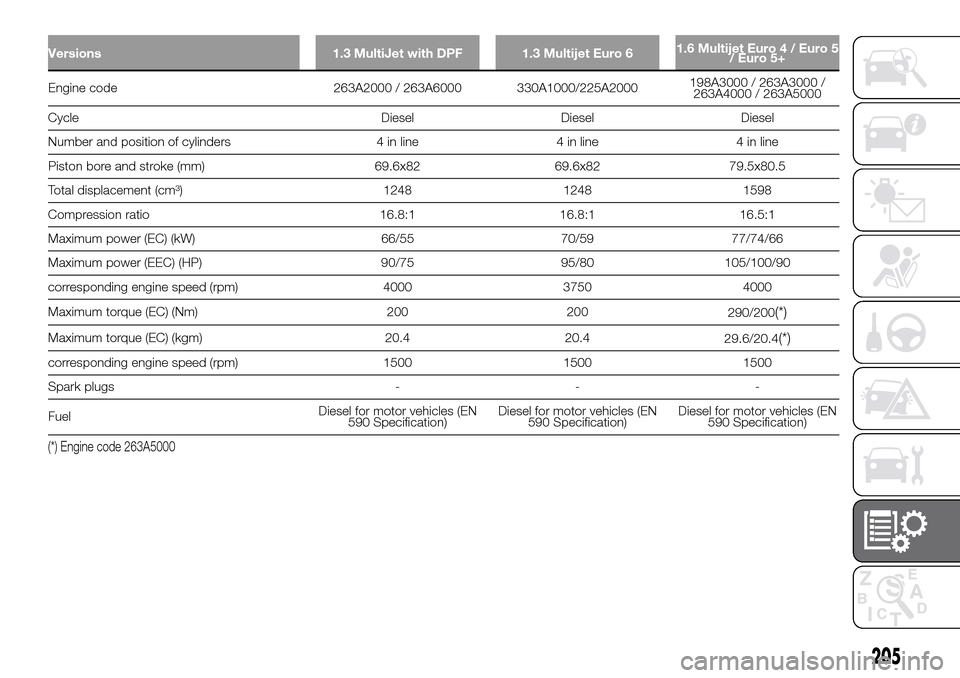
Versions 1.3 MultiJet with DPF 1.3 Multijet Euro 61.6 Multijet Euro 4 / Euro 5
/ Euro 5+
Engine code 263A2000 / 263A6000 330A1000/225A2000198A3000 / 263A3000 /
263A4000 / 263A5000
Cycle Diesel Diesel Diesel
Number and position of cylinders 4 in line 4 in line 4 in line
Piston bore and stroke (mm) 69.6x82 69.6x82 79.5x80.5
Total displacement (cm³) 1248 1248 1598
Compression ratio 16.8:1 16.8:1 16.5:1
Maximum power (EC) (kW) 66/55 70/59 77/74/66
Maximum power (EEC) (HP) 90/75 95/80 105/100/90
corresponding engine speed (rpm) 4000 3750 4000
Maximum torque (EC) (Nm) 200 200
290/200
(*)
Maximum torque (EC) (kgm) 20.4 20.4
29.6/20.4(*)
corresponding engine speed (rpm) 1500 1500 1500
Spark plugs - - -
FuelDiesel for motor vehicles (EN
590 Specification)Diesel for motor vehicles (EN
590 Specification)Diesel for motor vehicles (EN
590 Specification)
(*) Engine code 263A5000
205
Page 210 of 298
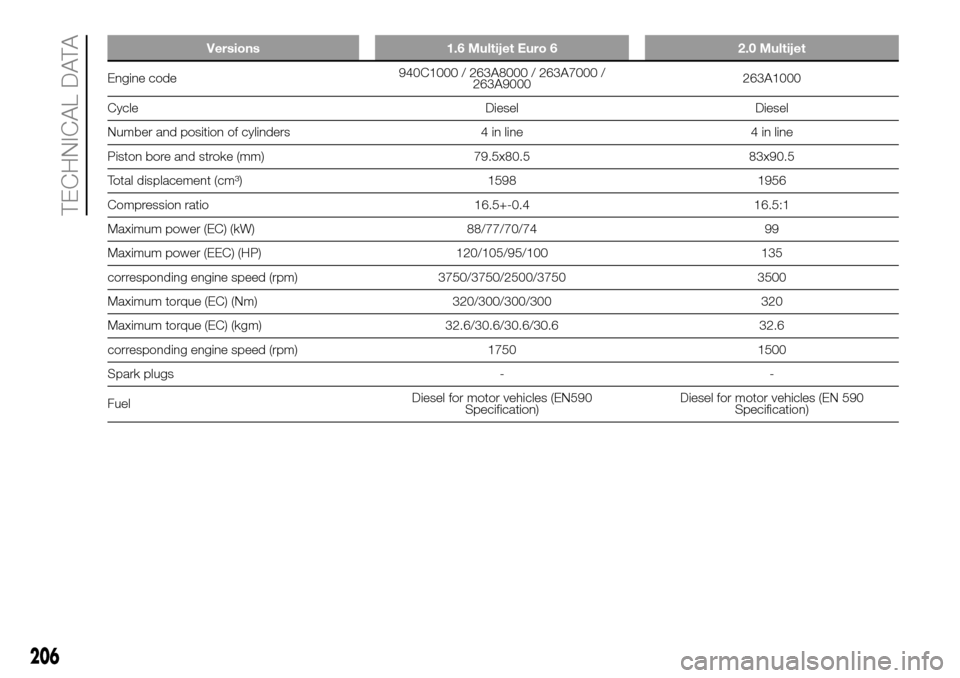
Versions 1.6 Multijet Euro 6 2.0 Multijet
Engine code940C1000 / 263A8000 / 263A7000 /
263A9000263A1000
Cycle Diesel Diesel
Number and position of cylinders 4 in line 4 in line
Piston bore and stroke (mm) 79.5x80.5 83x90.5
Total displacement (cm³) 1598 1956
Compression ratio 16.5+-0.4 16.5:1
Maximum power (EC) (kW) 88/77/70/74 99
Maximum power (EEC) (HP) 120/105/95/100 135
corresponding engine speed (rpm) 3750/3750/2500/3750 3500
Maximum torque (EC) (Nm) 320/300/300/300 320
Maximum torque (EC) (kgm) 32.6/30.6/30.6/30.6 32.6
corresponding engine speed (rpm) 1750 1500
Spark plugs - -
FuelDiesel for motor vehicles (EN590
Specification)Diesel for motor vehicles (EN 590
Specification)
206
TECHNICAL DATA